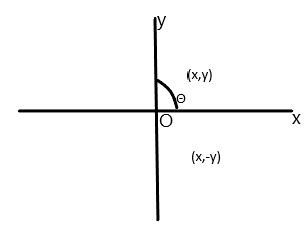
If $z$ and $\overline z $ represent adjacent vertices of a regular polygon of $n$ sides with centre at origin and if $\dfrac{{\operatorname{Im} z}}{{\operatorname{Re} z}} = \sqrt 2 - 1$, then the value of $n$ is equal to
A) $2$
B) $4$
C) $6$
D) $8$
Answer
504.3k+ views
Hint: First of all we should know that a regular polygon is a polygon that has equal sides and equal angles. In this question we should know that we have complex numbers. We can assume that ${z_1} = x + iy$, then the value of $\overline {{z_1}} $ will be $x - iy$. We know that the angle between two corresponding vertices is $\dfrac{{2\pi }}{n}$.
Complete step by step solution:
Let us assume that ${z_1}$ be the first vertex of the polygon in the first quadrant i.e. ${z_1} = x + iy$, then the $\overline {{z_1}} $ be in the fourth quadrant i.e. $\overline {{z_1}} = x - iy$.

In the above figure we have points in the first quadrant as $(x,y)$ and in the fourth quadrant the coordinates are $(x, - y)$.
Now we have assumed that the angle at the centre in the first quadrant is $\theta $.
So we can write from the question that $\tan \theta = \sqrt 2 - 1$. We know that the angle between two corresponding vertices is $\dfrac{{2\pi }}{n}$. From this we can write $\dfrac{{2\pi }}{n} = 2\theta $, because $\dfrac{\pi }{n} = \theta $ from the above figure.
By multiplying with $\tan $ on both the sides, it gives us $\tan \dfrac{{2\pi }}{n} = \tan 2\theta $. On simplifying this we can write $\tan \dfrac{{2\pi }}{n} = \dfrac{{2\tan \theta }}{{1 - {{\tan }^2}\theta }}$.
By putting the value of $\tan \theta = \sqrt 2 - 1$in the right hand side of the equation, we have$\dfrac{{2(\sqrt 2 - 1)}}{{1 - {{(\sqrt 2 - 1)}^2}}}$.
We will solve it now: $\dfrac{{2\sqrt 2 - 2}}{{1 - 2 - 1 + 2\sqrt 2 }} \Rightarrow \dfrac{{2\sqrt 2 - 2}}{{2\sqrt 2 - 2}}$. It gives us the value $\tan \dfrac{{2\pi }}{n} = 1$.
Now we know that the value of $\tan \dfrac{\pi }{4}$ is $1$, so we can write it as $\tan \dfrac{{2\pi }}{n} = \tan \dfrac{\pi }{4} = 1$.
Therefore we can write by eliminating tan, $\dfrac{{2\pi }}{n} = \dfrac{\pi }{4}$. It gives us the value of $n = 4 \times 2 = 8$.
Hence the required answer is (D) $8$.
Note:
We should know that we have used the trigonometric identity in the above question i.e. $\tan 2\theta = \dfrac{{2\tan \theta }}{{1 - {{\tan }^2}\theta }}$. We have also applied the algebraic identity of difference square formula which is ${(a - b)^2} = {a^2} + {b^2} - 2ab$. Before solving this kind of question we should have a clear knowledge of the trigonometric identities and their functions.
Complete step by step solution:
Let us assume that ${z_1}$ be the first vertex of the polygon in the first quadrant i.e. ${z_1} = x + iy$, then the $\overline {{z_1}} $ be in the fourth quadrant i.e. $\overline {{z_1}} = x - iy$.

In the above figure we have points in the first quadrant as $(x,y)$ and in the fourth quadrant the coordinates are $(x, - y)$.
Now we have assumed that the angle at the centre in the first quadrant is $\theta $.
So we can write from the question that $\tan \theta = \sqrt 2 - 1$. We know that the angle between two corresponding vertices is $\dfrac{{2\pi }}{n}$. From this we can write $\dfrac{{2\pi }}{n} = 2\theta $, because $\dfrac{\pi }{n} = \theta $ from the above figure.
By multiplying with $\tan $ on both the sides, it gives us $\tan \dfrac{{2\pi }}{n} = \tan 2\theta $. On simplifying this we can write $\tan \dfrac{{2\pi }}{n} = \dfrac{{2\tan \theta }}{{1 - {{\tan }^2}\theta }}$.
By putting the value of $\tan \theta = \sqrt 2 - 1$in the right hand side of the equation, we have$\dfrac{{2(\sqrt 2 - 1)}}{{1 - {{(\sqrt 2 - 1)}^2}}}$.
We will solve it now: $\dfrac{{2\sqrt 2 - 2}}{{1 - 2 - 1 + 2\sqrt 2 }} \Rightarrow \dfrac{{2\sqrt 2 - 2}}{{2\sqrt 2 - 2}}$. It gives us the value $\tan \dfrac{{2\pi }}{n} = 1$.
Now we know that the value of $\tan \dfrac{\pi }{4}$ is $1$, so we can write it as $\tan \dfrac{{2\pi }}{n} = \tan \dfrac{\pi }{4} = 1$.
Therefore we can write by eliminating tan, $\dfrac{{2\pi }}{n} = \dfrac{\pi }{4}$. It gives us the value of $n = 4 \times 2 = 8$.
Hence the required answer is (D) $8$.
Note:
We should know that we have used the trigonometric identity in the above question i.e. $\tan 2\theta = \dfrac{{2\tan \theta }}{{1 - {{\tan }^2}\theta }}$. We have also applied the algebraic identity of difference square formula which is ${(a - b)^2} = {a^2} + {b^2} - 2ab$. Before solving this kind of question we should have a clear knowledge of the trigonometric identities and their functions.
Recently Updated Pages
Master Class 12 Business Studies: Engaging Questions & Answers for Success

Master Class 12 Economics: Engaging Questions & Answers for Success

Master Class 12 English: Engaging Questions & Answers for Success

Master Class 12 Maths: Engaging Questions & Answers for Success

Master Class 12 Social Science: Engaging Questions & Answers for Success

Master Class 12 Chemistry: Engaging Questions & Answers for Success

Trending doubts
What is meant by exothermic and endothermic reactions class 11 chemistry CBSE

Which animal has three hearts class 11 biology CBSE

10 examples of friction in our daily life

One Metric ton is equal to kg A 10000 B 1000 C 100 class 11 physics CBSE

1 Quintal is equal to a 110 kg b 10 kg c 100kg d 1000 class 11 physics CBSE

Difference Between Prokaryotic Cells and Eukaryotic Cells




